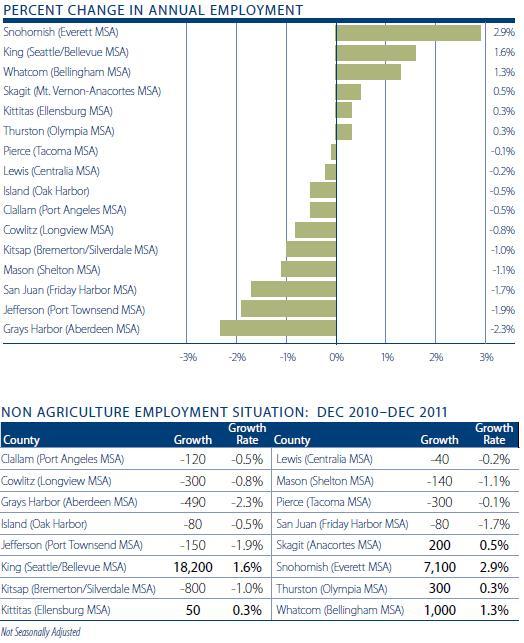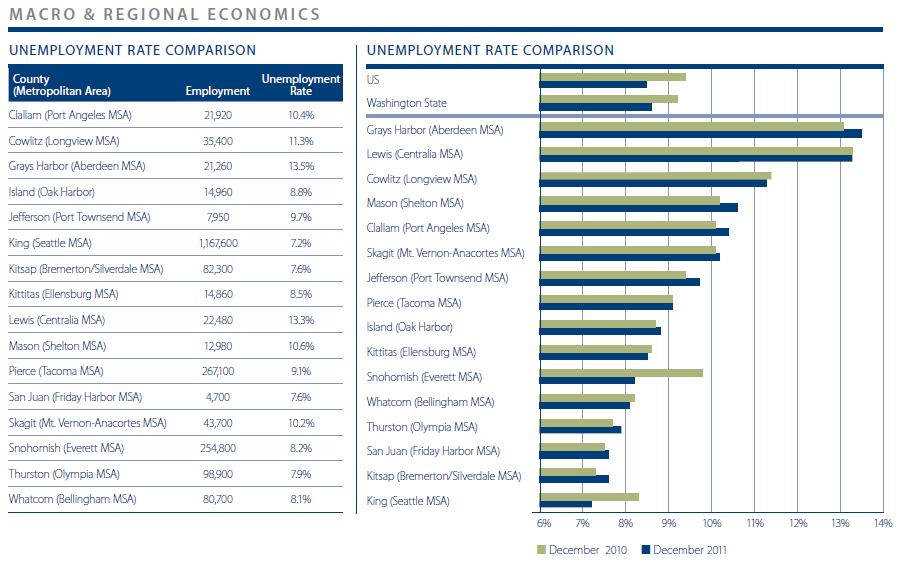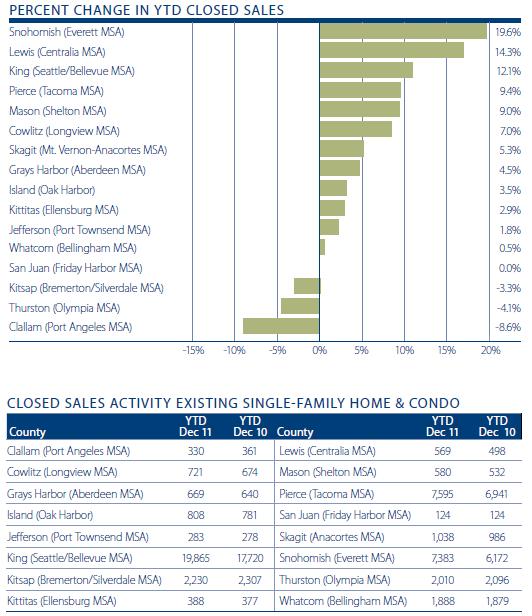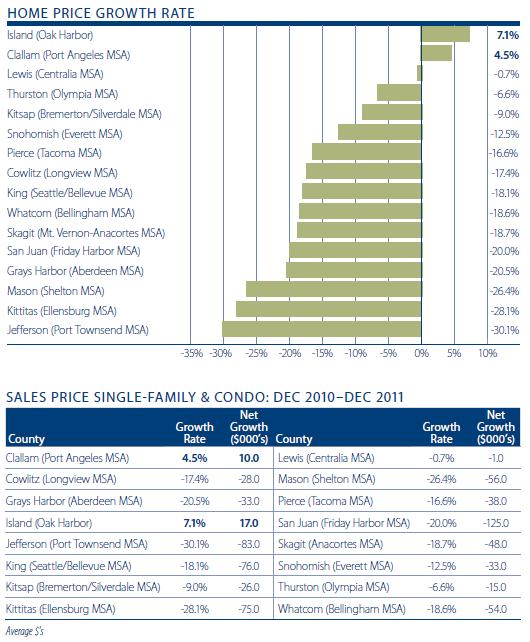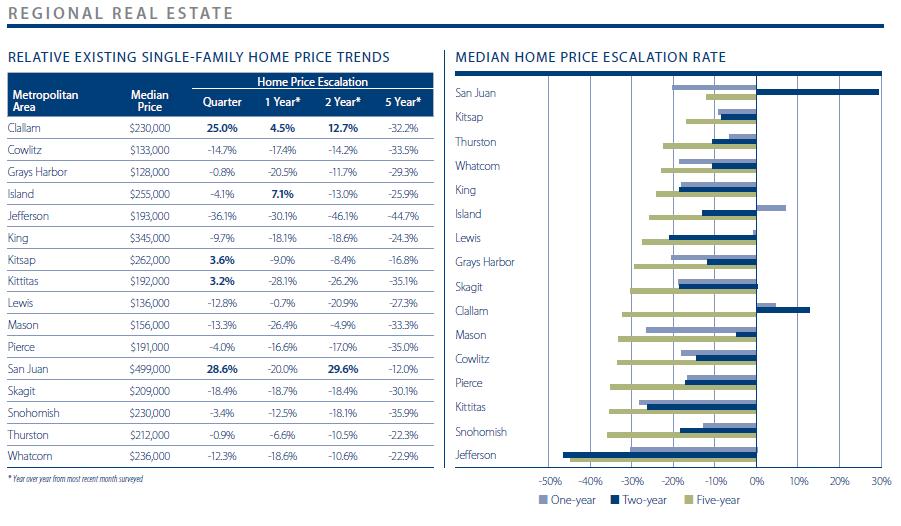Prepared exclusively for Windermere Real Estate
Windermere Real Estate is proud to partner with Gardner Economics on this analysis of the Western Washington real estate market. This report is designed to offer insight into the realities of the housing market. Numbers alone do not always give an accurate picture of local economic conditions; therefore our goal is to provide an explanation of what the statistics mean and how they impact the Western Washington housing economy. We hope that this information may assist you with making an informed real estate decision. For further information about the real estate market in your area, please contact your Windermere agent.
MACRO & REGIONAL ECONOMICS
As I look back on 2011, I do so with mixed emotions. On the positive side, Washington State’s job market made significant inroads into the job losses that were seen during the recession and, although the unemployment rate remains elevated, it is heading in the right direction.
In 2011 we saw some solid job gains with the region adding 24,350 positions, representing a 1.1 percent growth rate. As the charts to the right demonstrate, the increase was seen in six counties with contraction in the other ten. That said, when I look at changes from the third quarter, even those markets that lost jobs are contracting at a slower rate, which is encouraging. Layoffs in the government sector are still acting as an anchor to growth and I do not expect this to change in 2012—even with the private sector doing its best to pick up the slack.
Six counties experienced a net increase in employment which matched that seen in the third quarter. There were few surprises here, with the major employment centers seeing the greatest increase in growth. Snohomish (2.9%), King (1.6%), and Whatcom (1.3%) Counties led the way in year-over-year growth. Job losses were most profound in Grays Harbor County (-2.3%), followed by Jefferson County (-1.9%), San Juan County (-1.7%), Mason County (-1.1%) and Kitsap County (-1.0%).
From an unemployment rate perspective, there was modest improvement over the past quarter (and past year) with five counties showing improvement, two remaining static, and nine faring worse than a year ago. Not surprisingly, the greatest improvements were found in the areas of highest job concentrations with Snohomish and King Counties leading the way. Markets where the unemployment rate grew the most were Grays Harbor, Mason, Kitsap, Jefferson and Clallam Counties.
Considering that in 2010 our market created just 1,550 jobs and in 2011 this increased to 24,350, I am going to give the current employment situation a “C+” grade, up a notch from the last quarter. My expectations for 2012 remain positive, but the headwinds that are being generated both in Washington, D.C. and Europe may affect the speed of our recovery.
REGIONAL REAL ESTATE
Sales transactions in 2011 demonstrated remarkable growth of 9.7 percent over 2010. When compared to 2010, we note that all but four counties saw an increase in transactions with one essentially showing no change and three showing less sales in 2011 than the prior year. The largest increases in overall sales were seen in Snohomish (+20%), Lewis (+14%), and King Counties (+12%). Declines were seen in Clallam (-9%), Thurston (-4%), and Kitsap Counties (-3.3%).
As has been the case for all of 2011, an increase in sales does not mean an increase in prices. The value of transacted units in our market declined by 15.5 percent from a year ago, excluding the volatile San Juan County which saw a drop of 14.8 percent. Looking at the specific counties within our survey, there were two that exhibited price growth from December of 2010, these being Island (+7.1%) and Clallam (+4.5%). Counties that saw the greatest price declines included: Jefferson (-30.1%), Kittitas (-28%), Mason (-26.4%), Grays Harbor (-20.5%), and San Juan (-20%).
There are, I believe, two reasons why we have not yet seen the price stability that we are all looking for. The first of these is that the sale of distressed homes continues to make up a very large percentage of all transactions and these homes sell for substantially lower than market price. In King County, for example, distressed transactions made up 40 percent of all sales in 2011. Additionally, with such low levels of supply, we have seen a pronounced change in the make-up of sales with a disproportionate percentage of homes selling in very affordable price ranges. Both of these factors are having negative effects on home prices.
I am keeping the housing market at a “C-“ grade this quarter and am unlikely to change this until we start to see more housing choices become available and the percentage of foreclosures start to decline.
CONCLUSIONS
From an economic perspective, I will not budge from my contention that Washington State represents the best of all West Coast markets from the standpoint of economic potential. The diversification in our employment base and consistent growth in private companies puts us heads-and-shoulders above our counterparts.
In as much as I certainly do not expect the state to return to its prior peak employment soon—we are still shy by 154,000 jobs at a state level and 71,000 in the Seattle area—there are tangible signs of improvement that are encouraging.
The local real estate market remains unsettled, with distressed transactions accounting for a disproportionate percentage of overall sales. It continues to be important to get these cleared before we will start to see noticeable improvement. That said, the percentage price difference between foreclosure/short sales and market rate sales is shrinking; a sure sign that value is being found in many markets.
I remain a “glass half full” analyst and believe that we will continue to see improvement in all indices in 2012.
ABOUT MATTHEW GARDNER
Mr. Gardner is a land use economist and principal with Gardner Economics and is considered by many to be one of the foremost real estate analysts in the Pacific Northwest.
In addition to managing his consulting practice, Mr. Gardner is a member of the Pacific Real Estate Institute; chairs the Board of Trustees for the Washington State Center for Real Estate Research; the Urban Land Institutes Technical Assistance Panel; and represents the Master Builders Association as an in-house economist.
He has appeared on CNN, NBC and NPR news services to discuss real estate issues, and is regularly cited in the Wall Street Journal and all local media. Mr. Gardner is also available for speaking engagements. Please call 206.442.9200 or email ge.admin@gardnereconomics.com for more information.
 Facebook
Facebook
 X
X
 Pinterest
Pinterest
 Copy Link
Copy Link
